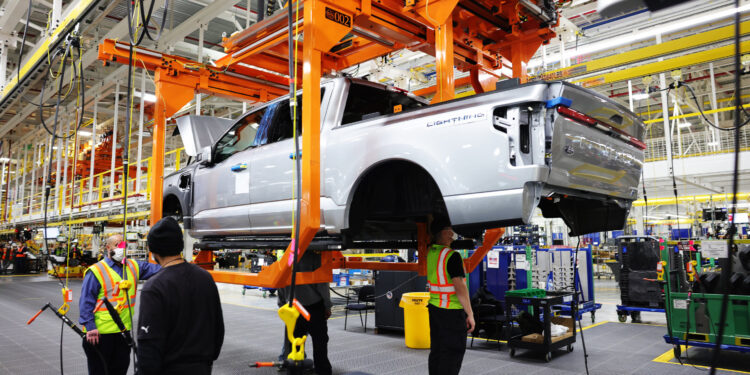Workers at a Ford plant in Dearborn, Michigan, work under the body of an all-electric 2022 Ford F-150 Lightning. Credit: Brenda Ahearn, Michigan Engineering
U.S. auto plants producing battery-electric vehicles required more labor than traditional internal combustion engine plants, a result that runs counter to early predictions about the impact of electric vehicles on the industry.
Researchers at the University of Michigan have shown that factories transitioning to large-scale production of electric vehicles have seen their assembly workforce increase tenfold. In one of the factories studied, which has been producing electric vehicles for more than a decade, the number of workers needed to make each vehicle remained three times higher.
“There is a lack of information about how the transition is happening,” said Anna Stefanopoulou, William Clay Ford Professor of Technology and lead author of the study published in Communication about nature. “What we’re seeing, with the data that’s available, is that the job loss that was predicted for electric vehicles is not happening.”
Previous estimates of the impact of electric vehicle production on auto workers have suggested a 30 to 40 percent reduction, or a loss of 200,000 jobs or more. This is largely due to the fundamental difference between electric and gasoline-powered cars.
Electric vehicles require about 100 fewer parts than their internal combustion engine counterparts, and their powertrain designs are much simpler. Transmissions, exhaust and cooling systems are not part of the EV equation, so assembly jobs were expected to be eliminated. But the results show otherwise.
The UM research team outlined several factors that may be contributing to the increase in the number of assembly workers in electric vehicle plants, including:
- Investment in the development of new manufacturing technologies, which often require more labor to improve.
- Increased vehicle complexity. Companies that start manufacturing electric vehicles typically start by manufacturing high-end vehicles with the most advanced features and technologies.
- Some manufacturers have consolidated their workers into one central location to reduce the costs associated with outsourcing, a practice known as vertical integration.
The 30% job loss figure is often attributed to James Hackett, former Ford chairman and CEO, according to a 2017 forecast.
“It’s a number that’s been repeated by a lot of big names in the auto industry,” said Omar Ahmed, a UM graduate research assistant and co-first author of the study. “But if you look closely, no one has really done the work to look at actual factories that have transitioned from building internal combustion vehicles to building electric vehicles.”
The UM researchers identified three factories that have transitioned from making all internal combustion engines to making all electric vehicles simultaneously. They are Tesla’s Fremont, California, factory (formerly owned by General Motors and Toyota), Rivian’s Normal, Illinois, factory (formerly operated by Mitsubishi), and General Motors’ Orion Township, Michigan, factory (now decommissioned).
The team compiled two decades of data on the number of assembly workers at the three plants using U.S. public census data, as well as production data from the Automotive News Research & Data Center.
“Our work clearly shows that the number of assembly workers in factories has increased in many cases,” said Andrew Weng, a U-M mechanical engineering researcher and co-first author of the study. “However, the jury is still out on jobs in parts manufacturing, which will depend largely on where the battery cells are made.”
Tesla’s Fremont plant offers the longest period of electric vehicle production to study. Gabriel Ehrlich, a research associate and director of the UM Quantitative Economics Research Seminar, said data from that auto plant can be useful.
“The plant has been operating for ten years now and they have clearly been successful in improving workforce efficiency,” he said. “But the pace of improvements indicates that it can take up to 15 years for a plant to reach parity with its ICE predecessor.”
“It will be a slow process, giving communities, businesses and workers time to adapt.”
More information:
Andrew Weng et al., Higher labor intensity in US automobile assembly plants after the transition to electric vehicles, Nature Communications (2024). DOI: 10.1038/s41467-024-52435-x
Provided by the University of Michigan
Quote:Research shows auto plants increased staffing levels after transition to electric vehicle production (2024, September 17) retrieved September 17, 2024 from
This document is subject to copyright. Apart from any fair dealing for the purpose of private study or research, no part may be reproduced without written permission. The content is provided for informational purposes only.



